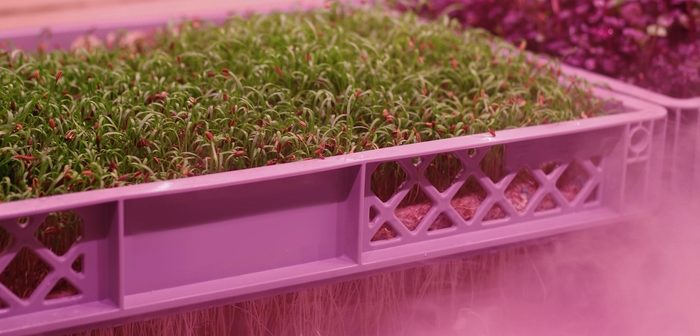A new study has outlined the potential of soil-free, computer-controlled farms as climate change and soil erosion limit our ability to grow crops. The research, published in New Phytologist and led by scientists at the University of Bristol, John Innes Centre and LettUs Grow, describe the growing environmental and economic case for vertical farming methods which could see crops grown in previously unfarmable environments such as the deserts of Dubai to countries with short daylight hours like Iceland.
Vertical farming is a type of indoor agriculture where crops are cultivated in stacked systems with water, lighting and nutrient sources carefully controlled and supported by artificial intelligence in which machines are taught to manage day-to-day horticultural tasks.
Part of a rapidly growing sector, vertical farming is set to grow by 21 per cent by 2025 according to recent forecasts1. With many environmental benefits including better use of space because vertical farms can be sited in urban locations, such as disused tunnels or unsuitable brownfield urban areas, fewer food miles, isolation from pathogens, reduction in soil degradation and nutrient and water recapturing and recycling. Vertical farms also help product consistency, price stabilisation, and cultivation at latitudes incompatible with certain crops such as the desert or arctic.
The interdisciplinary study combining biology and engineering identifies future research areas needed to increase the sustainable growth of vertical farming using precision agriculture, including aeroponic cultivation methods which uses nutrient-enriched aerosols in place of soil that are applied directly to the roots. This method is believed to resolve many of the physiological constraints that occur using hydroponic systems, such as improved aeration around the roots, meaning yields of up to 70 per cent greater can be achieved. However, the systems need extensive farm infrastructure and control technology.
Bethany Eldridge, a researcher at the University of Bristol studying root-environment interactions and lead author of the study, explains: “Given that 80 per cent of agricultural land worldwide is reported to have moderate or severe erosion, the ability to grow crops in a soil-free system with minimal fertilisers and pesticides is advantageous because it provides an opportunity to grow crops in areas facing soil erosion or other environmental issues such as algal blooms in local water bodies that may have been driven by traditional, soil-based, agriculture.
“We are aware that higher yields can be obtained from plants grown in aeroponic vertical farming set-ups, however, we still have relatively little knowledge about how plants grow and respond to the soil less growing environment during aeroponic cultivation.
“For example, similar to your gut microbiota that play an important role in digesting your food and helping you to take up vital nutrients and minerals, plants also form a community of microbes around their roots that help promote plant growth. However, the formation of these microbial communities around the roots is very sensitive to the environment that plants are grown in and we have very little knowledge about how these microbiomes may form during aeroponic vertical farming. This knowledge would be important for fine-tuning the growing environment to encourage the growth of these beneficial microbes or the development of a probiotic mixture, similar to a probiotic yoghurt, that could be added as a supplement to help boost plant performance.”
The report argues that a driver of technological innovation in vertical farms is minimising operation costs whilst maximising productivity, and that investment in fundamental biological research has a significant role. Therefore, the researchers seek to understand:
- Why aeroponic cultivation can be more productive than hydroponic or soil cultivation.
- The relationship between aeroponic cultivation and 24-hour circadian rhythms of plants.
- Root development of a range of crops in aeroponic conditions.
- The relationship between aerosol droplet size and deposition and plant performance.
- How we can establish frameworks for comparing vertical farming technologies for a range of crops.
- How aeroponic methods affect microbial interactions with plant roots.
- The nature of recycling of root exudates (compounds secreted by the roots of plants) within the nutrient solutions of closed aeroponic systems.
During the current global pandemic vertical farms in Dundee have demonstrated on a small scale how this type of farming can be an important component of a reliable food supply chain amidst shortages, however knowledge gaps remain and this study highlights the future research needed to understand how plants grow and respond during aeroponic cultivation.
Dr Antony Dodd, a research group leader at the John Innes Centre and one of the senior authors of the study, adds: “In this study we set out a strategic road map for the future of vertical farming to underpin increased productivity and sustainability. By bringing fundamental biological insights into how plants best respond to aeroponic cultivation we can help the vertical farming business become more efficient, more quickly, while producing healthier food with less environmental impact.”
Jack Farmer, chief Scientific Officer at LettUs Grow, a company specialising in aeroponic systems founded by former Bristol students, and one of the senior authors of the study, added: “This multidisciplinary collaboration will guide the sustainable and economically beneficial intensification of vertical farming that may vastly differ between location, crops and economies.
“Climate change is only going to increase the demand for this technology. Projected changes in regional weather patterns and water availability are likely to impact agricultural productivity in the near future. Vertical farming offers the ability to grow high-value nutritious crops in a climate-resilient manner all year round, proving a reliable income stream for growers.”
Lilly Manzoni, head of Research and Development at LettUs Grow and one the authors of the study added: “This paper is unique because it is broader than a typical plant research paper, it combines the expertise of engineers, aerosol scientists, plant biologists and horticulturalists. The wonderful thing about controlled environment agriculture and aeroponics is that it is truly interdisciplinary.”




